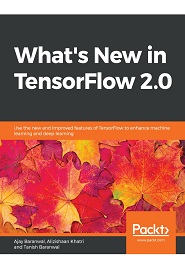
English | 2019 | ISBN: 978-1838823856 | 202 Pages | PDF, EPUB | 15 MB
Get to grips with key structural changes in TensorFlow 2.0
TensorFlow is an end-to-end machine learning platform for experts as well as beginners, and its new version, TensorFlow 2.0 (TF 2.0), improves its simplicity and ease of use. This book will help you understand and utilize the latest TensorFlow features.
What’s New in TensorFlow 2.0 starts by focusing on advanced concepts such as the new TensorFlow Keras APIs, eager execution, and efficient distribution strategies that help you to run your machine learning models on multiple GPUs and TPUs. The book then takes you through the process of building data ingestion and training pipelines, and it provides recommendations and best practices for feeding data to models created using the new tf.keras API. You’ll explore the process of building an inference pipeline using TF Serving and other multi-platform deployments before moving on to explore the newly released AIY, which is essentially do-it-yourself AI. This book delves into the core APIs to help you build unified convolutional and recurrent layers and use TensorBoard to visualize deep learning models using what-if analysis.
By the end of the book, you’ll have learned about compatibility between TF 2.0 and TF 1.x and be able to migrate to TF 2.0 smoothly.
What you will learn
- Implement tf.keras APIs in TF 2.0 to build, train, and deploy production-grade models
- Build models with Keras integration and eager execution
- Explore distribution strategies to run models on GPUs and TPUs
- Perform what-if analysis with TensorBoard across a variety of models
- Discover Vision Kit, Voice Kit, and the Edge TPU for model deployments
- Build complex input data pipelines for ingesting large training datasets
Resolve the captcha to access the links!